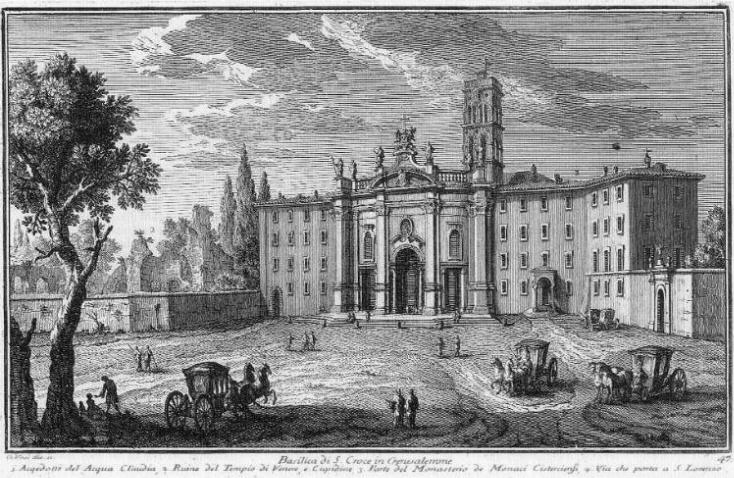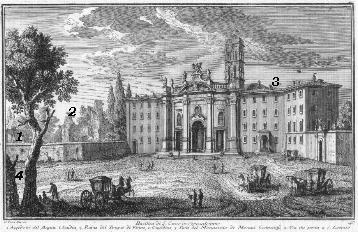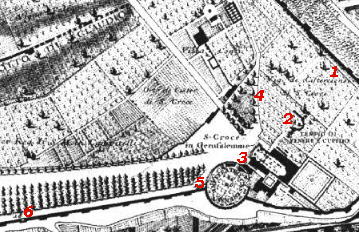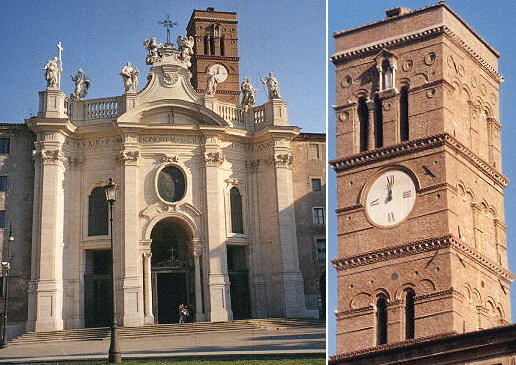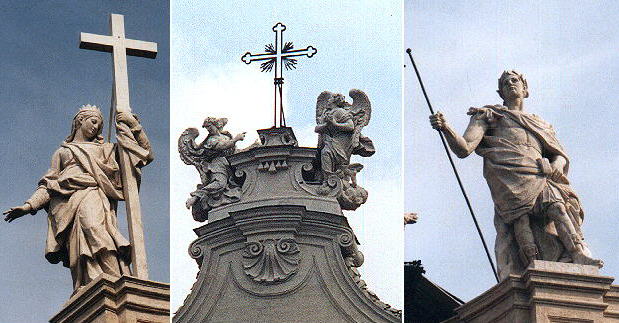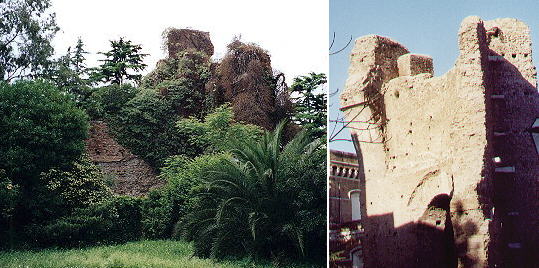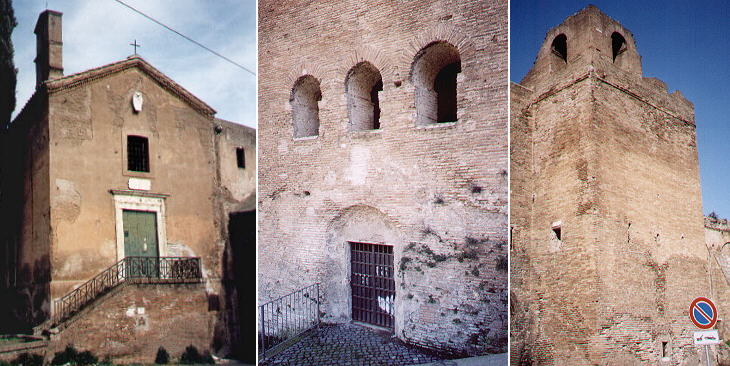

S. Croce
in Gerusalemme (Book
3) (Map
A4) (Day 1) (View B9) (Rione Monti)
In this page:
The plate by Giuseppe Vasi
Today's view
S. Croce in Gerusalemme
Temple of Venus
S. Maria del Buon Aiuto and Oratorio di S. Margherita
The Plate (No. 47)
S. Croce in Gerusalemme is one of the seven basilicas, which were visited by the pilgrims. It is said to have been erected
by St. Helena in honour of the cross she found in Jerusalem. At the time of the plate
the fašade had just been rebuilt (1743) by Domenico Gregorini and Pietro
Passalacqua. The view is taken from the green dot in the small 1748 map below.
In the description below the plate Vasi made reference to: 1) Acquedotto dell'Acqua Claudia; 2) Tempio di Venere e Cupido;
3) Monastery; 4) Street leading to S. Lorenzo. 1) is covered in another page. The small map shows also 5) S. Maria del Buon Aiuto; 6) Oratorio
di S. Margherita.
Today
S. Croce is no longer in a remote area of Rome, nevertheless, apart from the loss of the coat of
arms of Benedictus XIV, little
has changed.
S.
Croce in Gerusalemme
The fašade is the swansong of Roman Baroque architecture. Poor, grotesque,
bizarre are the adjectives describing it in most guides of the XIXth century,
thus confirming that the fašade owes a lot to Bernini's and Borromini's
masterpieces. As in many other baroque churches the fašade is crowned by gigantic statues of saints and angels.
Constantine, son of St. Helena, is the only Roman Emperor celebrated
in a church. In S. Croce he is portrayed with his mother.
Temple
of Venus
A lost city in the Amazonian forest? No just the ruins of the Temple
of Venus near S. Croce in Gerusalemme at the peak of the Roman summer (and in winter).
S. Maria del
Buon Aiuto
Sixtus IV (1471-84) built a little chapel next to the Roman Amphiteatrum Castrense
(the large oval building between the basilica and the chapel).
The chapel appeals to those who wish to pray for the souls of those in Purgatory.
The chapel is known also as S. Maria del Soccorso or S. Maria de Spazolaria.
Oratorio di S. Margherita is pretty hard to find as this chapel is located in a tower of the Roman
walls: the tower, unlike the others, has some windows on the inner side of the walls and a sort of bell tower
at its top. The chapel was pretty popular in the XVIIth and XVIIIth centuries, but later on its existence was forgotten.
Excerpts from Giuseppe Vasi 1761 Itinerary related to this page:
Basilica di S. Croce in Gerusalemme
Fu questa eretta dall'Imperatore Costantino ad istanza di s. Elena sua madre nel suo
palazzo Sessoriano per collocarvi il legno della ss. Croce, che aveva portato da
Gerusalemme, e per˛ ne prese il titolo ed il nome. Dopo molti riattamenti fu ultimamente
rinnovata dal Pontefice Benedetto XIV. col disegno del Cav. Passalacqua Messinese, ed Ŕ
ornata con pitture, e stucchi dorati; quelle nella volta, nella crociata, e i due laterali a
fresco fatti nella tribuna sono di Corrado Giaquinto; il quadro nella prima cappella a
destra Ŕ di Gio. Bonatti, quello nella seconda di Carlo Maratti, e nella terza dipinse
il Cav. Vanni. Il ritrovamento della ss. Croce dipinto nella tribuna sembra maniera di
Pietro Perugino. Dalla porticella a destra si scende ad una devota cappella divisa in due,
una dedicata alla ss. PietÓ, e l'altra alla s. Imperatrice, nella quale ella aveva fatto
riporre della terra portata da' luoghi santi di Gerusalemme: perci˛ non Ŕ lecito di
entrarvi le donne, ed Ŕ ornata di mosaici e di marmi. I quadri ne' tre altari sono di
Pietro Paolo Rubens, e le pitture a fresco del Pomaranci. Il bassorilievo della PietÓ Ŕ
opera di autore incerto, ed il deposito del Cardinal Besozzi Ŕ d'Innocenzo Spinazzi.
Tornando poi in chiesa, il quadro del primo altare Ŕ di Luigi Garzi, ed il s. Tommaso nell'
ultima Ŕ di Giuseppe Passeri. ╚ questa una delle sette chiese, ed Ŕ ufiziata da' monaci
Cisterciensi. Lo stradone d'incontro, che porta alla basilica di s. Maria Maggiore,
fu fatto da Sisto V. e quello a sinistra, che va al Laterano, dal mentovato Benedetto XIV.
Nella vigna a destra si vedono delle rovine, e li credono essere del
tempio di Venere, e Cupido.
Camminando poi appresso le mura, poco dopo la divisata porta di s. Giovanni,
evvi una piccola cappelletta in cui si fa memoria di s. Margherita.
|
Next plate in Book 3: Basilica
di S. Lorenzo fuori le Mura
You have completed Day 1! Move to Day 2.
Next step in your tour of Rione Monti: Porta S. Giovanni

Go
to  or to Book
3 or to my Home
Page on Baroque Rome or to my Home Page on Rome
in the footsteps of an XVIIIth century traveller.
or to Book
3 or to my Home
Page on Baroque Rome or to my Home Page on Rome
in the footsteps of an XVIIIth century traveller.
|


